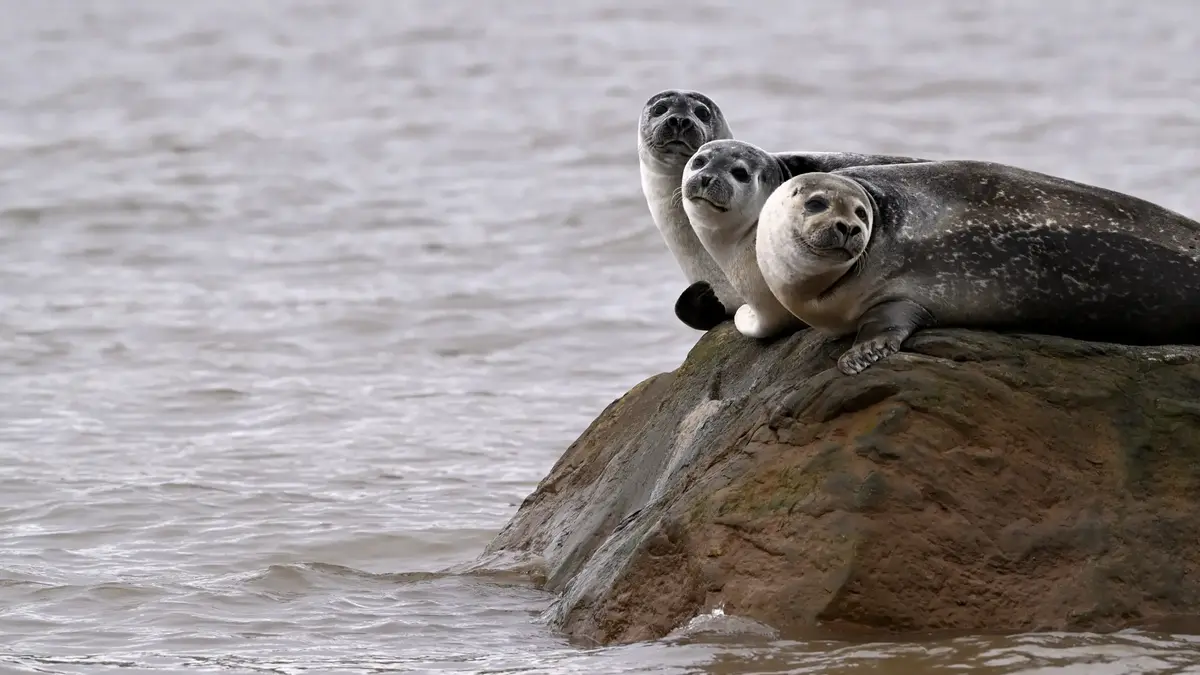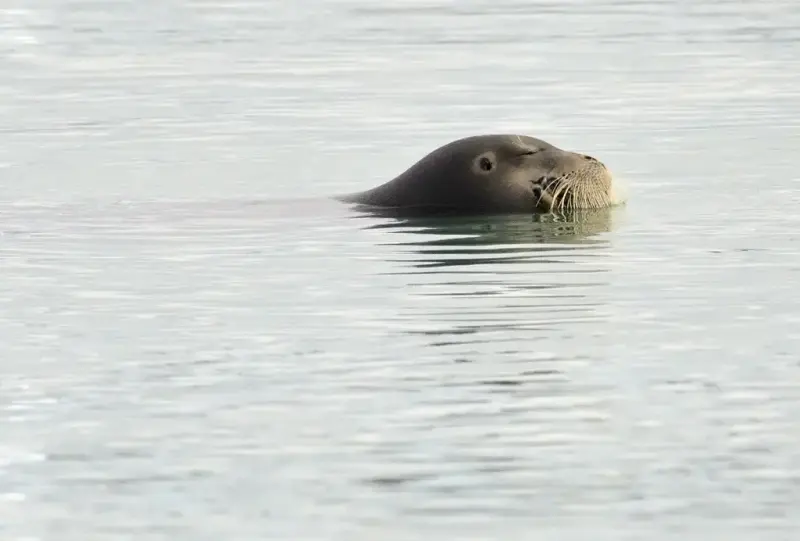Bowhead whale (Balaena mysticetus)
The bowhead whale is a large baleen whale. It can grow to 18 metres and weigh 100 tonnes. Females are generally larger than males. The bowhead is the only species of baleen whale that spends its entire life in the Arctic.
Beluga (Delphinapterus leucas)
These toothed whales are the most common species of whale in Svalbard. Like all the whales that are permanent Svalbard residents, they lack a dorsal fin. Adult males are about 4,5 metres long and weigh over 1500 kg. Females are slightly smaller. Calves are grey-brown at birth. As they age they become first dark grey, then lighter grey; ultimately, a couple years after becoming sexually mature, they take on their characteristic white colour. This toothed whale lives in all-male groups, or in mixed groups of females, immature whales, and calves.
Narwhal (Monodon monoceros)
This toothed whale is relatively rare in Svalbard waters. Males have a ‘tusk’ up to 2,5 metres in length. Its body is shaped rather like that of a beluga, but the colouration is completely different, with mottled dark spots all over, especially on the back. The narwhal is a deep diver, regularly diving more than 1000 metres.
Minke whale (Balaenoptera acutorostrata)
The minke whale is the smallest of our baleen whales, but can be 10 metres long and weigh 8–10 tonnes. It has a characteristic white band on the upper side of its flippers. The minke is a summer visitor that eats a variety of fish and invertebrates. While in Svalbard, it mainly lives on krill. The whales reach sexual maturity at 6–7 years of age, and fertile females give birth one calf per year.
Fin whale (Balaenoptera physalus)
The fin whale is a large baleen whale that can grow to 22–24 metres and weigh 60–80 tonnes. The colouration on the whale’s head is distinctly asymmetrical: the left side is dark grey, whereas the lower right side is white. Fin whales are summer visitors that eat various crustaceans and schooling fish. They become sexually mature at age 6–8 and produce a calf every other year.
Humpback whale (Megaptera novaeangliae)
The humpback whale grows to 14 metres and weighs as much as 60 tonnes. This baleen whale is the most well known of the big whales and easiest to identify. Its build is more powerful than that of other members of the fin whale family, and they have a rounder head which is covered with skin bumps called tubercles. Their flippers are extremely long and unevenly curved on the leading edge; the flippers are also nearly always white on the underside and sometimes also on the top. Humpback whales visit Svalbard in the summer, when they eat krill and other crustaceans, as well as schooling fish. They become sexually mature at five years of age and produce a calf once every two years.
Killer whale (Orcinus orca)
Killer whales are easy to recognise because of their distinctive colouration and conspicuous dorsal fin. These toothed whales are black and white, with black dominating on their backs. They have a white spot around each eye and one stretching from their underside up either flank to between the dorsal fin and the tail fin. They also have a grey saddle-shaped spot behind the dorsal fin. Males are considerably larger than females, and have a much larger triangular dorsal fin. Males reach a length of 9 metres and weigh 5,5 tonnes. The killer whale eats many species of fish, but also warm-blooded animals such as seals and whales – even blue whales. Males reach sexual maturity at age 15; females somewhat earlier.
Dolphins
Dolphins are small toothed whales. Although there are many dolphin species, it is essentially only the white-beaked dolphin (Lagenorhynchus albirostris) that frequents Svalbard waters. ‘White-beaks’ grow to 2,5–3 metres and weigh up to 350 kg. They eat fish and generally congregates in pods. They often approach boats to play in the bow wave.
Ringed seal
The ringed seal is the most common seal species in Svalbard; it can also be found in icy waters throughout the Arctic all the way to the North Pole. It is about 130 centimetres long and weighs between 50 and 100 kilogrammes, depending on the season. Both sexes look alike except that adult males’ faces become dark during the mating season.
Ringed seals are able to open up breathing holes through pack ice by using the claws on their front flippers. This gives them access to areas deep within the pack ice – areas no other seal species can reach. Ringed seals excavate caves in the snow above these holes. There they can rest, and pregnant females usually give birth in such caves. Most ringed seal pups in Svalbard are born during the first week of April. The birthing caves protect the pups from wind and weather, and to some degree also from predators. This is because it takes time for a polar bear or an arctic fox to dig through the snow and into the cave. The seals hear this and have a chance to escape to another cave or breathing hole. Svalbard’s ringed seals become sexually mature at 4–5 years of age, and females produce a pup every year for the rest of their lives. The oldest known ringed seal was 45 years old and lived in Svalbard. These seals generally dive only to modest depths – rarely deeper than 100 metres – and dives last less than ten minutes. However, Svalbard ringed seals outfitted with recording instruments have been shown to dive to 500 metres and be underwater for over 45 minutes. Polar cod is the seal’s main prey, but they also eat many other things, especially various crustaceans and other species of fish. The ringed seal itself is the main prey of polar bears, and ringed seal pups are an important component of the arctic fox’s diet.
Harbour seal
The world’s northernmost population of harbour seals live in Svalbard, mainly on the west coast of Prins Karls Forland. They generally stay within a small geographic area. Males grow to about 150 cm, weigh 105 kg, and attain sexual maturity at age six; females grow to 140 cm, weigh 85 kg, and become sexually mature at age four. Pups are born in the second half of June. Harbour seals can easily be mistaken for ringed seals, but their fur usually has a more mottled appearance, while the fur of ringed seals often shows the characteristic rings.
The harbour seal is probably an opportunistic feeder, eating whatever fish species are available.

